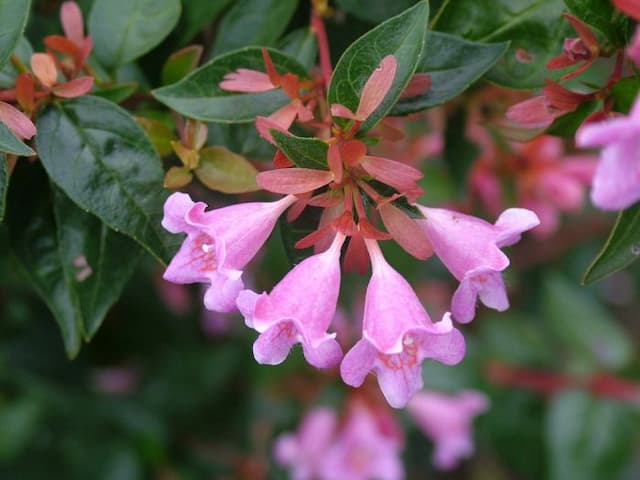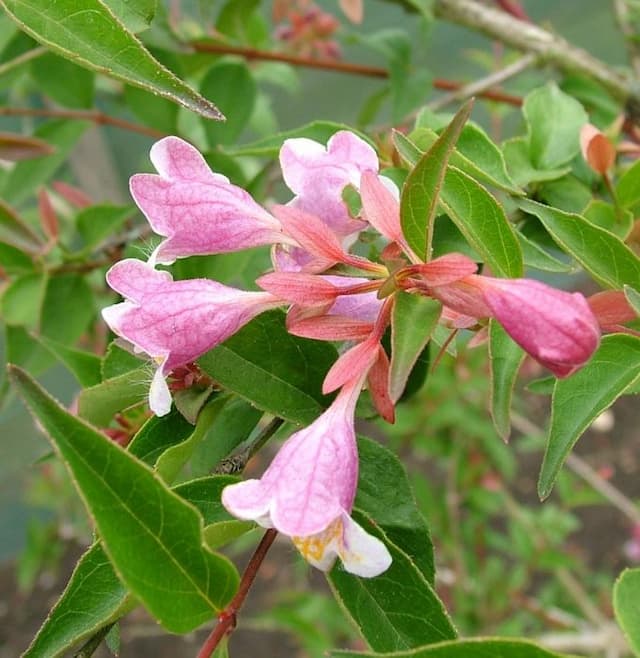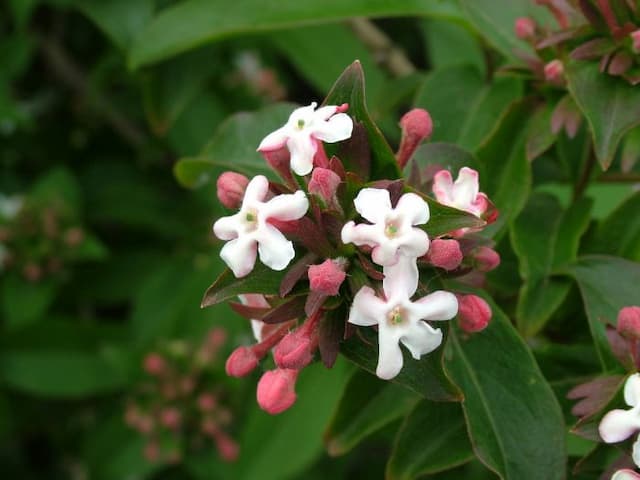Honeysuckle Lonicera periclymenum 'Graham Thomas'

ABOUT
The plant known as 'Graham Thomas' is a variety of honeysuckle that is admired for its striking and aromatic flowers. The plant features long, twining stems that bear oval-shaped, bright green leaves arranged opposite along the stems. The leaves provide a lush backdrop to the standout feature of this plant, its flowers. The blooms are trumpet-shaped with a flared lip and are typically a creamy white color that transitions to a deep yellow as they mature. These dual-toned flowers are arranged in whorled clusters that dangle gracefully from the plant, inviting pollinators such as bees and hummingbirds. The blooms emit a strong, sweet fragrance, especially during the evening, making it a desirable plant for night gardens or near sitting areas where the scent can be enjoyed. After the flowering period, the honeysuckle may produce small, red berries that can provide a visual interest as well as a food source for birds, though they are not edible for humans. The overall appearance of 'Graham Thomas' honeysuckle is one of vibrant green foliage paired with captivating, sweet-smelling yellow flowers, making it a favored choice for trellises, fences, and arbors where it can add height and a vertical element to the garden without reference to its actual size.
About this plant
 Names
NamesSynonyms
Graham Thomas Honeysuckle, Woodbine 'Graham Thomas'.
Common names
Lonicera periclymenum 'Graham Thomas'
 Toxicity
ToxicityTo humans
Honeysuckle plants, including the variety Lonicera periclymenum 'Graham Thomas', have parts that can be toxic when ingested by humans. It is generally not considered highly toxic, but eating parts of the plant, such as berries, can potentially result in symptoms like nausea, vomiting, diarrhea, and stomach upset. Accidental ingestion of small quantities might not cause severe reactions, but larger amounts, particularly of the berries, can lead to more significant symptoms. As with any suspected poisoning, medical attention should be sought if symptoms appear after consuming parts of the honeysuckle plant.
To pets
Honeysuckle, the common name for Lonicera periclymenum 'Graham Thomas', can also be toxic to pets if ingested. It is especially toxic to cats and dogs. Symptoms of honeysuckle poisoning in pets may include vomiting, diarrhea, lethargy, and in more severe cases, it can lead to elevated heart rate, labored breathing, or convulsions. While honeysuckle is not usually considered highly toxic to pets, it is best to prevent pets from ingesting the plant, and immediate veterinary care should be sought if a pet exhibits any symptoms after consumption.
 Characteristics
CharacteristicsLife cycle
Perennials
Foliage type
Deciduous
Color of leaves
Green
Flower color
Cream
Height
10-15 feet (3-4.5 meters)
Spread
6-10 feet (1.8-3 meters)
Plant type
Climber
Hardiness zones
5
Native area
Europe
Benefits
 General Benefits
General Benefits- Attractive Flowers: Produces large, fragrant cream to yellow flowers that are visually appealing and can brighten up any garden space.
- Wildlife Friendly: Attracts a variety of pollinators, including bees, butterflies, and hummingbirds, helping to support local ecosystems.
- Low Maintenance: Once established, requires minimal care, making it a good choice for gardeners of all skill levels.
- Fast Growing: Can quickly cover fences, walls, or trellises, providing a lush backdrop or privacy screen.
- Drought Tolerant: Once established, it has good resistance to periods of dry weather, reducing the need for frequent watering.
- Long Blooming Period: Blooms from late spring to late summer, providing a long season of interest in the garden.
- Erosion Control: When planted on slopes or banks, can help reduce soil erosion with its spreading root system.
- Ornamental Use: Popular as a cut flower and often used in floral arrangements for its beauty and fragrance.
- Edible Berries: Produces red berries that, while not the tastiest, can be used to make preserves or syrups.
- Versatile Planting: Can be grown in a variety of soil types and conditions, making it suitable for many different garden settings.
 Medical Properties
Medical Properties- Anti-inflammatory: Lonicera periclymenum may have compounds with anti-inflammatory effects.
- Antibacterial: The plant has been reported to have antibacterial properties that could potentially inhibit the growth of certain bacteria.
- Antioxidant: The presence of antioxidants in the plant may help in neutralizing free radicals in the body.
 Air-purifying Qualities
Air-purifying QualitiesThis plant is not specifically known for air purifying qualities.
 Other Uses
Other Uses- Lonicera periclymenum 'Graham Thomas', commonly known as honeysuckle, can be trained to grow along fences and walls, creating natural privacy screens.
- Gardeners may use the honeysuckle to provide support for other climbing plants, such as clematis, by planting them together.
- The long stems of honeysuckle can be woven into wreaths or other floral arrangements as part of natural craft projects.
- The dense foliage and robust growth of honeysuckle can be used to provide shade in sunny gardens by training it onto pergolas or arbors.
- With its fragrant flowers, honeysuckle is often planted near windows or patios to allow the sweet scent to drift into homes and outdoor living spaces.
- Honeysuckle can be used in educational settings to teach principles of plant growth, pollination, and wildlife relationships.
- The plant is a good choice for erosion control due to its vigorous root system and ability to thrive in a range of soil conditions.
- By providing nectar-rich flowers, honeysuckle can be an integral part of butterfly and bee gardens designed to support pollinator populations.
- Honeysuckle can be used as part of natural dye processes, as certain parts of the plant may yield colorants for fabrics and yarns.
- As an ornamental feature, the fruits of the honeysuckle can add visual interest to the garden with their red or black berries, depending on the variety.
Interesting Facts
 Feng Shui
Feng ShuiThe Honeysuckle is not used in Feng Shui practice.
 Zodiac Sign Compitability
Zodiac Sign CompitabilityThe Honeysuckle is not used in astrology practice.
 Plant Symbolism
Plant Symbolism- Love and Devotion: Lonicera periclymenum, commonly known as Honeysuckle, often symbolizes devoted affection due to its ability to cling to the structures it grows on, much like love clings to the heart.
- Bonds of Friendship: The interwoven growth of Honeysuckle vines can represent the interconnectedness and strong bonds of friendship.
- Generosity: With its copious and sweet blossoms, Honeysuckle can symbolize the generous provision of nature and the abundant gifts of the Earth.
- Happiness: The sweet scent and bright flowers of the Honeysuckle often evoke feelings of joy and contentment, symbolizing happiness.
- Protection: As Honeysuckle plants can create a dense foliage, they are sometimes viewed as a symbol of protection and a safe haven.
- Nostalgia: The distinctive fragrance of Honeysuckle can trigger memories of childhood and symbolize longing or affection for the days gone by.
 Water
WaterHoneysuckle 'Graham Thomas' should be watered deeply once a week during its active growing season, providing it with about 1-2 gallons per watering session depending on the size and maturity of the plant. In hot or dry weather, the frequency may need to increase to twice a week. Ensure the soil is moist but not waterlogged, as this plant does not like to sit in wet soil. During the dormant season, reduce watering to every few weeks, just enough to prevent the soil from drying out completely.
 Light
LightHoneysuckle 'Graham Thomas' thrives best in full sun to partial shade conditions. The ideal spot would be where the plant receives at least 6 hours of direct sunlight daily, with some afternoon shade to protect it from the intense heat of the day.
 Temperature
TemperatureHoneysuckle 'Graham Thomas' can survive a range of temperatures, from winter lows around 20°F to summer highs of 90°F or more. However, its ideal growing temperature is between 60°F and 80°F. The plant is quite hardy and can tolerate brief periods of colder temperatures, provided the roots are well-mulched.
 Pruning
PruningFor Honeysuckle 'Graham Thomas', pruning is essential to encourage healthy growth and abundant flowering. Prune lightly in late winter or early spring before new growth begins, removing any dead or overgrown branches. After blooming, prune as needed to shape the plant or control its size. The best time for major pruning is after the plant has flowered, usually in late summer.
 Cleaning
CleaningAs needed
 Soil
SoilHoneysuckle 'Graham Thomas' thrives in well-drained, fertile loam with a pH of 5.5 to 7.5. A good soil mix is equal parts garden soil, compost, and peat or leaf mold.
 Repotting
RepottingHoneysuckle 'Graham Thomas' does not typically require frequent repotting; repot every 3-4 years to refresh soil and manage root growth.
 Humidity & Misting
Humidity & MistingHoneysuckle 'Graham Thomas' prefers average to high humidity levels but is generally adaptable to a wide range of humidity conditions.
 Suitable locations
Suitable locationsIndoor
Provide bright indirect light and train onto a support structure.
Outdoor
Plant in sun to part shade; support with trellis or fence.
Hardiness zone
4-9 USDA
 Life cycle
Life cycleThe Lonicera periclymenum 'Graham Thomas', commonly known as Honeysuckle 'Graham Thomas', starts its life cycle when seeds germinate in the spring, although propagation is often through cuttings to maintain cultivar traits. The young plant grows rapidly, developing into a climbing or bushy shrub with twining stems. During the second to third year, after establishing a robust root system and vegetative growth, it begins to produce fragrant, yellow-white tubular flowers in late spring to summer. After pollination by insects, primarily moths attracted by the strong nighttime fragrance, the flowers develop into red to black berries by late summer or autumn. These berries contain seeds which may be dispersed by birds and can lead to new plants if conditions are favorable. In winter, the plant may lose some or all of its foliage, entering a period of dormancy, although in milder climates, it can retain its leaves year-round.
 Propogation
PropogationPropogation time
Late summer to autumn
The Lonicera periclymenum 'Graham Thomas', commonly known as Honeysuckle, can be propagated effectively using semi-hardwood cuttings. This method is best performed in late summer, when the growth from the current year has begun to mature and harden slightly. To propagate by semi-hardwood cuttings, a gardener should select a healthy, non-flowering shoot and make a cut to create a segment approximately 6 inches (15 centimeters) in length. The lower leaves should be removed, and the cutting can be dipped into rooting hormone to encourage root development. The prepared cutting is then planted in a well-draining potting mix, ensuring that the leaf nodes, where roots are likely to form, are buried. The pot should be placed in a warm environment with indirect sunlight and kept consistently moist. Roots typically develop within a few weeks, after which the new Honeysuckle plant can be gradually acclimated to outdoor conditions and eventually transplanted into the garden.







![Himalayan honeysuckle [Golden Lanterns]](/_next/image?url=https%3A%2F%2Fplants-admin.emdemapps.com%2Fimages%2Fplants%2F%2Fimages%2F604b55302cc87.png&w=640&q=75)

